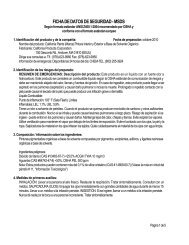Craftsman Signature Color Stories - California Paints
Craftsman Signature Color Stories - California Paints
Craftsman Signature Color Stories - California Paints
Create successful ePaper yourself
Turn your PDF publications into a flip-book with our unique Google optimized e-Paper software.
<strong>Color</strong> Name Period <strong>Color</strong> Story<br />
Rosy Opal<br />
Rustic Green<br />
Sea Oats<br />
Seascape Jade<br />
Sleeper's Entry<br />
South Gallery<br />
Stickley Straw<br />
1900-1920<br />
<strong>Craftsman</strong>/Arts & Crafts<br />
1900-1920<br />
<strong>Craftsman</strong>/Arts & Crafts<br />
1900-1920<br />
<strong>Craftsman</strong>/Arts & Crafts<br />
1900-1920<br />
<strong>Craftsman</strong>/Arts & Crafts<br />
1900-1920<br />
<strong>Craftsman</strong>/Arts & Crafts<br />
1900-1920<br />
<strong>Craftsman</strong>/Arts & Crafts<br />
1900-1920<br />
<strong>Craftsman</strong>/Arts & Crafts<br />
This rosy coral comes from a 1907 wallpaper border where accents of bright jewel colors appeared in<br />
patterns depicting everything from Aztec geometrics to tapestry-textured florals.<br />
Jewelry with enamel, opal and semi-precious stones was a popular fashion trend in the early 20 th<br />
century.<br />
A darker version of Sea Oats, this shade from a 1916 exterior paint is a typical color of this period.<br />
<strong>Craftsman</strong> and Tudor revival homes used multiple exterior sheathing material, including stucco. This<br />
color, along with ochre, rust, or olive, could appropriately be used on the stucco or exterior trim of a<br />
bungalow.<br />
Almost the color of a paper bag, this golden tan shade comes from a 1916 paint color. A typical color<br />
of the <strong>Craftsman</strong> period, the gold tones of oak furniture and woodwork carried over into all aspects of<br />
interior decoration.<br />
Soft blue-green on painted tables and Windsor chairs in Beauport’s Golden Step Room ties this<br />
magical early 20 th -century dining room to the seascape of Gloucester Harbor. Guests of tastemaker<br />
Henry Davis Sleeper dined informally alongside a bank of windows that could be lowered into the wall<br />
to open the room to the summer breezes. A collection of jade-green majolica displayed around the<br />
room further conveyed the color theme.<br />
This yellow ochre shade from the entry at Beauport (1907-1934) provides a sunny welcome.<br />
Beauport’s designer and owner, Henry Sleeper Davis had painted this shade of yellow on colonial<br />
paneling that he salvaged from the early 18 th century Cogswell House of Ipswich, Massachusetts. This<br />
yellow has been used both inside and outside for centuries and provides a timeless historic look for<br />
any traditional home.<br />
The South Gallery at Beauport is painted in this rich mocha brown. Shelves lined with books bound in<br />
cobalt blue leather create an unexpected accent to this room. Innovative interior designer, Henry<br />
Davis Sleeper, used similar color contrasts throughout his Gloucester summer home and was among<br />
the first to look to the 18 th century for color inspiration in the many fragments of colonial interior<br />
woodwork he salvaged and installed at Beauport.<br />
From a 1912 wallpaper, wheat shades emphasized the hand-crafted and natural aspects of arts and<br />
crafts style homes. Interior paint colors followed a rich palette of gold, olive, tan, and deep cream with<br />
dark or oak stained woodwork and bright accents in furnishings.<br />
Gustav Stickley, an architect and maker of hand-made wooden furniture, also founded The <strong>Craftsman</strong><br />
magazine. This publication gave name to the most popular design style in the early 20 th century, the<br />
<strong>Craftsman</strong> or Arts and Crafts movement.<br />
6












